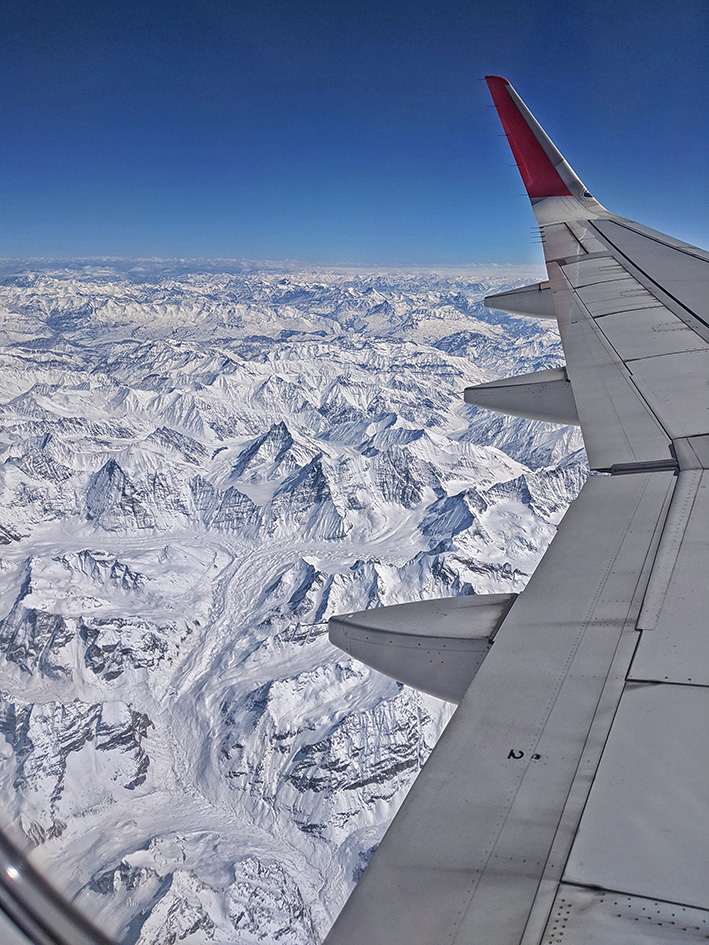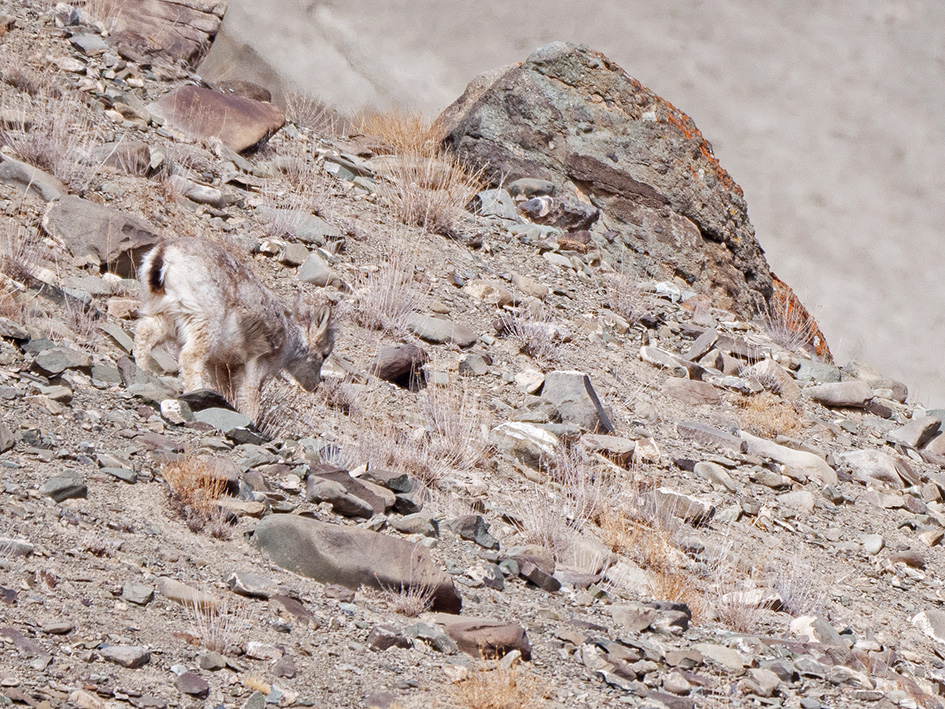A snow leopard trekking in Ladakh provides insights into the life of the big cats and sheds light on their future.
I didn’t know very much about snow leopards. What they look like, where they live and that there aren’t many left. Three very playful cubs at Krefeld Zoo aroused my curiosity a few years ago. How does the predator live and survive in the Himalayas‘ thin air? Why is it endangered? What about its future? A few reports and documentaries later, I heard about snow leopard trekking. Traveling to the big cat’s habitat? Of course!
Snow-capped peaks within reach and as far as the eye can see. The silence in the mountains swallows the roar of the Boeing that takes me from Delhi to Ladakh. From a hectic metropolis of 20 million people to a region of untouched nature. From a pleasant 20 degrees to the wintry cold of Leh, Ladakh’s capital. Konchok welcomes me there. He has been guiding tourists through the surrounding mountains for ten years – back then as a student of geopolitics: multi-day hikes and summit ascents in the summer, snow leopard trekking in the winter. That’s exactly why I’m here. When there is a lot of snow, the shy big cat leaves its habitat at up to 6,000 meters. It follows its prey to lower altitudes. This makes it easier for visitors to observe the ghost of the mountains, as the snow leopard is also known in the Himalayas. “We had fresh snow last week. That’s good for us,” says Konchok optimistically about the upcoming tour.

Wild Life Study Camp at an altitude of 4,000 meters
At 3,500 meters above sea level, Leh is one of the highest cities in the world. In the high-altitude air, it is advisable to take it easy for the first two days. After a night with a slight headache, an easy hike to the palace should help you acclimatize. The 17th century building is situated high above the city – even higher, judging by my lungs. On the third day, we set off for the Wild Life Study Camp at an altitude of 4,000 meters, our base for the search for snow leopards. The ascent is via a gravel road that is not too steep, but all the longer. For Konchok, it is one of many walks. He always takes time to point his spotting scope at the steep walls: “During the day, they usually sleep in the sun on the warm rocks.” Typical cat. On this afternoon, however, the mountainsides are empty. Snow leopards roam an area with a radius of around 50 kilometers. It takes a lot of luck to track them down. Their perfect camouflage also makes it difficult to spot them in the rocks as well as in the snow. The white-greyish fur with dark spots and circles blends in perfectly with the textures of the barren or snow-covered mountain world.

Rigzin and Gyadso, who had previously brought the main luggage up by donkey and mule, are already waiting at the camp. They will also take care of the food and drinks. A gabled tent made of dark green cotton serves as a dining room, while another doubles as a kitchen and bedroom for our hosts. I make myself at home in my own little geode. The night-time outside temperatures up here drop to minus 20 degrees Celsius. I rely on the combination of two down sleeping bags. Konchok is already on the move again: “We’ll keep looking for snow leopards as long as there’s light.” I join him. At a nearby spot, several other groups from this and a neighboring camp are pointing their spotting scopes or telephoto lenses at the distant mountains. People who stare at mountains. Some tracks in the snow are relatively easy to recognize, but to the layman they could be from any animal. Konchok knows the difference and directs my gaze to a gray spot that slowly but steadily climbs the snow-covered slope. The first snow leopard of the tour. The experience captivates me and heightens my anticipation for the coming days.

After another sighting on the second day, we are also able to observe a snow leopard on the third day. Despite the great distance, I recognize the typical features through the spotting scope. They make this big cat so special: Large paws act as snowshoes and provide perfect grip on the treacherous, steep rocks. Long, powerful hind legs allow the hunter to leap over ten meters. The impressive tail – which measures around one meter and warms the paws during sleep – serves as a balancing aid. Our snow leopard demonstrates this with an elegant leap from rock to rock. Evolution has optimized the snow leopard for hunting in the mountains. As the top predator, it dominates the food chain in the Himalayas. Its prey consists mainly of ungulates such as the blue sheep, but small mammals and birds are also on the menu. Despite the numerous blue sheep on the mountain slopes, we are denied hunting scenes. On the following days, after three impressive sightings, the snow leopard does not show itself again. Of course, Ladakh has much more to offer: We observe bearded vultures and golden eagles, snow hares and a lynx. The male dzo and the female dzomo are also omnipresent. The local farm animals are a cross between yak and domestic cattle. “Resilient like a yak and peaceful like a cow,” explains Konchok.

In the run-up to the trip, I came across a researcher who has turned his passion for the ghost of the mountains – now I know that the name is more than justified – into a vocation. Back in the early 1980s, Dr. Rodney Jackson tracked the migration of snow leopards for four years with the help of GPS transmitters. Since then, he has been fascinated by the animal. In 2000, he founded the Snow Leopard Conservancy. The non-profit organization works closely with communities within the snow leopard’s range, including in Pakistan, Nepal, Russia and India. The Snow Leopard Conservancy India Trust was founded as part of the Snow Leopard Conservancy and has been an independent non-profit organization since 2003, which today carries out the majority of projects in Ladakh.

The protection of the snow leopard is necessary because, as a hunter, it contributes to the balance of the fauna. It is still a victim of poachers. Trade in the fur or bones – which are used in traditional Chinese medicine – has been banned since the 1970s. The black market still exists today. Another problem, as Dr. Rodney Jackson explains, is conflicts with the local population: “Especially in high-altitude villages, the snow leopard is a danger to livestock.” This threatens the existence of the people living there. Tsewang Namgail, Director of the Snow Leopard Conservancy India Trust, adds: “Buddhism forbids us from killing animals. But when the predator threatens their livelihood, many have no choice.” This makes it all the more important to understand the animal in order to respond with appropriate measures. The two organizations work hand in hand on sustainable solutions that preserve the animals‘ habitat and reduce killing. The most important pillars of this work are research, education and tourism.
“Securing the mostly open stables is an effective way to protect livestock,” says Dr. Rodney Jackson. But in most villages there is no money for roofing, so the cattle are practically crammed together on a platter. The Snow Leopard Conservancy has already been able to erect numerous roofs and fences with donations, but at over 1000 dollars per pen, the measure is too costly in the long term. That is why the focus is on cheaper solutions such as fox lights. The solar-powered warning lamps register the attacker via motion sensors and scare them off with flashes of light. Such systems have already been used in Africa to hunt poachers, adds Dr. Rodney Jackson: “The modern systems can even automatically send notifications to a smartphone.”

Prospects for the local population
In all efforts to reduce the potential for conflict between humans and animals, Dr. Rodney Jackson sees the greatest opportunity in education: “We go into the villages and talk to the locals about the value of the snow leopard for the region.” The persuasion work is paying off. “By imparting knowledge, we get children and young people in particular interested in the topic.” New collaborations are constantly emerging. “Some install wildlife cameras,” says Tsewang Namgail, giving an insight into the work he and his team do. Today, camera traps are an important tool for observing the snow leopard’s habitat. “The findings are incorporated into research work and, of course, into community education.” This is used to develop conservation concepts and ideas for tourism opportunities. “In this way, we not only offer the locals a perspective, we really get them excited about the animal with which they share a habitat.”

One of these perspectives are home stays – accommodation in the mountain villages, directly with the locals. These accommodation options are a win-win situation for everyone involved. An additional source of income for the providers and a brief insight into local life for the tourists. After nine nights in a tent, I am allowed to move into a room in Mrs. Tashi’s house. The 80-year-old has been hosting guests for several years. A large communal room warmed by a wood-burning stove is the heart of the traditional building. Here we spend a convivial evening enjoying typical local cuisine. I am allowed to help prepare the chutagi, a type of pasta. When asked about the snow leopards, Mrs. Tashi tells me that there have never been any problems in Rumbak Village.
Conservation measures as a continuous process
The work of the Snow Leopard Conservancy and the Snow Leopard Conservancy India Trust is an ongoing process from which nature and the population are already benefiting. Tourism is becoming more and more important in Ladakh as new trekking routes are being developed through home stays – even outside the snow leopard season. Dr. Rodney Jackson and Tsewang Namgail are therefore optimistic about the future: “We have created a good basis for the implementation of many more successful projects.”
The Red List of Species published by the International Union for Conservation of Nature and Natural Resources (IUCN) classifies the snow leopard as an endangered species. Different scenarios estimate a total population of between 2,500 and 10,000 specimens. According to the IUCN, these numbers are stable or even increasing slightly in some areas. According to the IUCN, this could be a result of increased surveys in previously unmapped areas, but the efforts of non-profit organizations such as the Snow Leopard Conservancy are also highlighted: “Conservation measures and guidelines have undoubtedly contributed to this.”

On the flight back to Delhi with the best view of the mountains, I realize what a unique experience my time in the Himalayas was. Completely different and sometimes more strenuous than all my previous trips, but also much more insightful. The silence in the mountains meant two weeks of peace, no stress, pure nature. A reality that is completely alien to most people today because they cannot escape the noise of the modern world. A reality that we should therefore also seek out where we live.